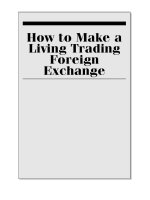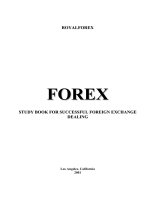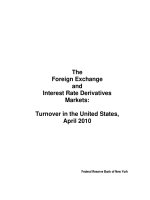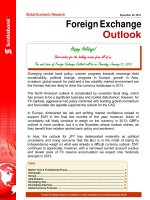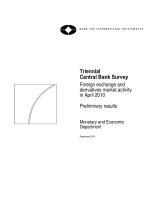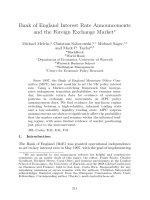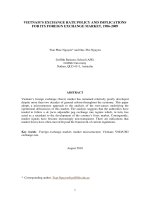Trading Foreign Exchange
Bạn đang xem bản rút gọn của tài liệu. Xem và tải ngay bản đầy đủ của tài liệu tại đây (5.14 MB, 208 trang )
P1: JYS
fm JWBT195-Smith November 27, 2009 20:51 Printer: Yet to come
How to Make a
Living Trading
Foreign
Exchange
i
P1: JYS
fm JWBT195-Smith November 27, 2009 20:51 Printer: Yet to come
Founded in 1807, John Wiley & Sons is the oldest independent publishing
company in the United States. With offices in North America, Europe,
Australia, and Asia, Wiley is globally committed to developing and mar-
keting print and electronic products and services for our customers’ pro-
fessional and personal knowledge and understanding.
The Wiley Trading series features books by traders who have survived
the market’s ever-changing temperament and have prospered—some by
reinventing systems, others by getting back to basics. Whether a novice
trader, professional, or somewhere in-between, these books will provide
the advice and strategies needed to prosper today and well into the future.
For a list of available titles, please visit our Web site at www.
WileyFinance.com.
ii
P1: JYS
fm JWBT195-Smith November 27, 2009 20:51 Printer: Yet to come
How to Make a
Living Trading
Foreign
Exchange
A Guaranteed Income for Life
COURTNEY D. SMITH
John Wiley & Sons, Inc.
iii
P1: JYS
fm JWBT195-Smith November 27, 2009 20:51 Printer: Yet to come
Copyright
C
2010 by Courtney D. Smith. All rights reserved.
Published by John Wiley & Sons, Inc., Hoboken, New Jersey.
Published simultaneously in Canada.
No part of this publication may be reproduced, stored in a retrieval system, or transmit-
ted in any form or by any means, electronic, mechanical, photocopying, recording, scan-
ning, or otherwise, except as permitted under Section 107 or 108 of the 1976 United States
Copyright Act, without either the prior written permission of the Publisher, or authorization
through payment of the appropriate per-copy fee to the Copyright Clearance Center, Inc., 222
Rosewood Drive, Danvers, MA 01923, (978) 750-8400, fax (978) 750-4470, or on the Web at
www.copyright.com. Requests to the Publisher for permission should be addressed to the Per-
missions Department, John Wiley & Sons, Inc., 111 River Street, Hoboken, NJ 07030, (201)
748-6011, fax (201) 748-6008, or online at www.wiley.com/go/permissions.
Limit of Liability/Disclaimer of Warranty: While the publisher and author have used their best
efforts in preparing this book, they make no representations or warranties with respect to the
accuracy or completeness of the contents of this book and specifically disclaim any implied
warranties of merchantability or fitness for a particular purpose. No warranty may be created
or extended by sales representatives or written sales materials. The advice and strategies con-
tained herein may not be suitable for your situation. You should consult with a professional
where appropriate. Neither the publisher nor author shall be liable for any loss of profit or any
other commercial damages, including but not limited to special, incidental, consequential, or
other damages.
For general information on our other products and services or for technical support, please
contact our Customer Care Department within the United States at (800) 762-2974, outside the
United States at (317) 572-3993 or fax (317) 572-4002.
Wiley also publishes its books in a variety of electronic formats. Some content that appears
in print may not be available in electronic books. For more information about Wiley products,
visit our Web site at www.wiley.com.
Library of Congress Cataloging-in-Publication Data:
Smith, Courtney, 1952–
How to make a living trading foreign exchange : a guaranteed income for life /
Courtney D. Smith.
p. cm. — (Wiley trading series)
Includes index.
ISBN 978-0-470-44229-6 (cloth)
1. Foreign exchange market. 2. Foreign exchange futures. 3. Investment analysis.
4. Risk management. I. Title.
HG3851.S59 2010
332.4
5–dc22
2009031709
Printed in the United States of America
10987654321
iv
P1: JYS
fm JWBT195-Smith November 27, 2009 20:51 Printer: Yet to come
To my parents and my foxhole buddy
v
P1: JYS
fm JWBT195-Smith November 27, 2009 20:51 Printer: Yet to come
vi
P1: JYS
fm JWBT195-Smith November 27, 2009 20:51 Printer: Yet to come
Contents
Preface xi
CHAPTER 1 The Basics of Foreign Exchange
Trading
1
Sell a Yard of Cable 2
Don’t Want to Trade! 4
Transaction Costs 7
It Never Stops 8
My Biggest Losing Trade 8
The Bottom Line 11
CHAPTER 2 Trend Analysis
13
What Is a Trend? 14
How to Profitably Trade Bull and Bear Markets 18
How to Trade the Trend 21
Megaphones and Pennants 25
Average Directional Index 27
The Bishop 28
The Bottom Line 30
CHAPTER 3 Channel Breakouts
31
The Beginnings of Channel Breakouts 31
What Is a Channel Breakout? 32
Better Channel Breakouts 35
The Pros and Cons of Channel Breakouts 39
vii
P1: JYS
fm JWBT195-Smith November 27, 2009 20:51 Printer: Yet to come
viii
CONTENTS
The Bishop 40
ADX Filter 43
The Principle of Instant Gratification 46
Rejection Rule 46
The Last Bar Technique 51
Tactics 52
Taking Profits 52
The Bottom Line 53
CHAPTER 4 The Conqueror
55
The Beginnings of the Conqueror 55
What Is True Range? 56
Enhancing the Conquistador 57
Adjusting the Stop 63
The Bottom Line 65
CHAPTER 5 Stochastics
67
What Are Stochastics? 67
How to Use Stochastics as an Overbought and
Oversold Indicator 69
Trading Signals from Crossovers 71
Profitability of Stochastics 74
Warnings 75
The Best Way to Make Money Using Stochastics 76
Go with the Trend 81
How I Use Stochastics 81
Interview with George Lane 82
The Bottom Line 89
CHAPTER 6 Pattern Recognition
91
Inside Days 91
Double Whammy 94
Multiunit Tactic 95
Reversal Days 97
P1: JYS
fm JWBT195-Smith November 27, 2009 20:51 Printer: Yet to come
Contents
ix
Riding the Rejection Rule 101
The Bottom Line 103
CHAPTER 7 Risk Management
105
Stopping Bad Risk Management 105
HowtoMakeSureWeAreNeverWipedOut 108
Good Risk Management: Fixed Fractional 108
How Many Contracts Should I Put On? 109
Highly Correlated Positions 109
Kelly Formula 110
Trade Your Equity Curve 114
TakeaTimeOut 115
Turning Poor Systems into Good Systems 115
How Big a Position Should I Take? 116
The Bottom Line: Diversify through Time 117
CHAPTER 8 Slingshot
119
The Importance of Minimizing Losses 120
Beware of Taking Profits Too Early 121
Psychological Profits 122
Confirmations 123
Maximum Excursion Analysis 124
Using the Slingshot for Profits 125
The Mini-Slingshot 128
The Bottom Line 130
CHAPTER 9 The Psychology of Successful
Trading
131
Why Do You Trade? 132
The Pressures of Trading 136
Why Do You Lose? 137
Addressing a Lack of Knowledge 138
Addressing a Lack of Capital 140
Addressing a Lack of Self-Discipline 141
P1: JYS
fm JWBT195-Smith November 27, 2009 20:51 Printer: Yet to come
x
CONTENTS
An Example of Overcoming the Bizarre Twists and
Turns of the Mind 143
Treat Trading as Education 144
Stress-Free Trading 147
Be the Casino 148
Developing Your Trading Plan 149
Filling Out the Plan 150
The Importance of a Postmortem 153
The Bottom Line 155
CHAPTER 10 Putting It All Together
157
Diversifying to Reduce Risk 157
Use a Mental Checklist 158
How to Trade Only One Method 159
The Bottom Line 160
Epilogue: Key Insights for Maximizing Your
Trading Profits 161
Appendix: Suggested Reading 177
Acknowledgments 179
About the Author 181
Index 183
P1: JYS
fm JWBT195-Smith November 27, 2009 20:51 Printer: Yet to come
Preface
T
rading foreign exchange (forex) is one of the most exciting and poten-
tially lucrative activities in the world. Yet about 90 percent of traders
lose money. This book is designed to create profitable traders.
Can you make a living trading forex?
Yes!
And no.
Let me explain.
It is common wisdom that about 90 percent of traders lose money trad-
ing forex, about 5 percent break even, and about 5 percent make money.
I have not seen any scientific evidence that this is true but I have talked
to senior executives at brokerage houses and they tell me that this is a
rough guide to what happens to traders. My own experience as a senior ex-
ecutive in the futures and options industry also confirms the same dreary
results.
There was a study by the federal government back in the 1960s of
futures traders and they found that futures traders had those same statis-
tics. However, the underlying data were not so dismal.
It was true that 90 percent lost money, but that was after commissions.
They actually had about a 7 percent return on their investment before com-
missions. The main reason that they were losing was commissions. The
theory back then was that the 7 percent gain was the equivalent of an
insurance premium that commercial companies paid to speculators to take
over the risk of the commercials. Trading forex does not incur any commis-
sions (and futures commissions are much lower now) so I doubt that this
factor is so important anymore.
However, forex does have other transaction costs in the form of the
bid/ask spread. The cost of buying at the ask and selling at the bid on every
trade is a significant drag on performance over a given year.
Let’s assume a $10,000 account trading mini-contracts. Let’s further as-
sume that there is a 3 pip bid/ask spread for each trade. Now assume that
we do almost one trade per day, or 250 trades per year. That comes to a
$750 expense off the top of trading. We have to overcome that vig each
xi
P1: JYS
fm JWBT195-Smith November 27, 2009 20:51 Printer: Yet to come
xii
PREFACE
year to make a profit. We effectively start out in the hole by 7.5 percent
when we start the year trading. We need to make at least 7.5 percent profit
just to break even.
I think those assumptions are similar to many traders’. Take a look at
your own experience to see where you stand and how much headwind you
have to overcome to break even.
It might actually be worse than that. The most common form of forex
trading is spot forex through a retail forex broker such as FXCM or Sterling
Gent. Brokers take an additional profit from the roll every day. I’ll explain
what the roll is in Chapter 1, but please note that brokers effectively take
a bid/ask spread every day. This is worth another, say, $3 per day per open
position. Let’s assume that you only have on one position per day and that
adds up to another $750 per year. We are now up to a 15 percent headwind
to make any money. Stock investors tend to make money but that is largely
because the stock market drifts higher over any decent, long period of
time, not because stock investors are better investors. In addition, there
is no time limit when you invest with stocks. Futures and options expire.
Forex doesn’t expire but the high leverage keeps people from hanging
on to positions for years the way they can with stocks. Investors will
often hang on to losing positions in stocks for years waiting for them
to return to profitability. That is technically possible in forex, but it’s
rarely done.
The high leverage creates a mentality toward trading that works
against traders. Basically, trading forex attracts a “get rich quick” mental-
ity that works against the trader. Contrast this mentality with the normal
stock investing mentality that looks to buy and hold.
The pressures of dealing with high leverage cause the usual forex
trader to make a lot of mistakes. And those mistakes cost more than in
the unleveraged stock world. The high leverage puts a lot of mental pres-
sure on the forex trader that is simply not there in as high a degree for a
stock trader.
The sum of all these differences is that the forex trader has a much
harder time making money than a stock trader. But . . .
The subtitle of this book is A Guaranteed Income for Life. This title
was inspired by an infamous poker book from 20 years ago. I truly believe
that the material in that book can create a guaranteed income for life. This
is not BS. Here’s what it requires: You must do exactly what I say to do in
this book. You must not deviate. You must execute flawlessly. Only after
you have mastered this material should you start to be creative. This
self-discipline is critical to your success. A lackadaisical attitude will put
you back in the category of a losing trader. You and I both don’t want that
to happen.
P1: JYS
fm JWBT195-Smith November 27, 2009 20:51 Printer: Yet to come
Preface
xiii
I can’t repeat it enough: Execute the plan in this book and you will be
a profitable trader. You will live a life that few can even comprehend.
I wrote much of this book while hanging out near the beach in Belize.
I’m writing this Preface on a plane to Singapore where I will first give a
speech to about 2,200 people and then relax in several Asian countries in
beach houses.
How can I do this? Internet access. That’s it. I do all my analysis and
trading online. I can’t live in the real boondocks because I need Internet
access but I can live a remarkable lifestyle anyway. My first stop after the
Singapore speech is a week in Bali.
Guess what? I don’t even really need constant Internet access. I really
only need Internet access for about 15 minutes a day. I prefer more than
that because I post a lot of instructional videos on my educational Web
sites and that takes more time and bandwidth. But how about just a few
minutes at an Internet caf
´
e in China or London or wherever? That’s all I
need. The true goal for me, and most people trading forex, is not to make a
lot of money but to gain freedom.
I know that I presented a rather dismal picture about how hard it is to
make money in the forex world. But I’m not only saying that you will make
money, I am also saying that you can have a guaranteed income for life.
This is a very strong statement.
How do I know that this is true? How can I be so sure?
I have spent many years training traders. I have been teaching these
techniques for over 25 years. More important, I have been training retail
investors with no experience at all trading let alone trading forex. It has
been a very gratifying experience. I have really enjoyed watching people
create a new life for themselves. Every single one of my retail educational
clients has made money trading forex, except one. (And he is down just
a little.)
At one point, I foolishly offered a mentoring program called Extreme
Profits. This was a short but intensive program that I charged $2,000 to
take. Here’s the insane part: I offered a money-back guarantee if students
didn’t double their money in a year. What an idiot I am!
All but one student doubled their money. These were normal retail in-
vestors; no trading pros in the group. The one woman who didn’t double
her money asked for her money back and I gave it to her. By the way, she
was up 70 percent for the year.
So I know that it can be done. I know that you can do it!
But (isn’t there always a but?) you must execute flawlessly.
That’s it. That’s the secret.
Now go through this book. Execute the plan. Make money. Live the life
you dream about.
P1: JYS
fm JWBT195-Smith November 27, 2009 20:51 Printer: Yet to come
xiv
PREFACE
OVERVIEW OF THE CONTENTS
I’ve designed this book to be useful for anyone who is interested in making
money trading forex, from novice to pro.
This book explains all the basics that a novice needs to know to get
going. At the same time, experienced traders will find the systems and
methods, particularly my enhancements of classic methods, to be of signif-
icant value. Every trader will find the sections on the psychology of trading
and risk management will sharply enhance their profitability.
Chapter 1 outlines the basic information you need to get started in trad-
ing forex. Perhaps you’ve traded stocks or mutual funds or even futures.
But I assume that you know nothing about trading forex. I’ve also included
a number of real stories of my trading, to give some flavor of the life of a
professional institutional trader. Even if you have some experience trading
forex, this chapter is worth reading for the examples.
Chapter 2 is where we really start the methods of making money in
the forex market. This chapter introduces trend analysis. This technique is
similar to what have been called 123s. However, I add in a unique method
to truly define which trends to jump onto and which ones to sidestep.
In addition, I introduce to the public for the first time the Bishop tech-
nique. This unique indicator has a tremendous track record of getting out
of trades at major highs or lows. It doesn’t give a lot of signals but you
should pay very close attention when it does. I will exit all my open posi-
tions on any technique whenever I see a Bishop buy or sell signal. It’s that
powerful.
I’m also introducing in this book a new way to filter trades. This fil-
ter eliminates about half of my losing trades while only eliminating about
5 percent of my winning trades. What a great tradeoff! It dramatically
enhances the profit of the trend analysis and other techniques.
Chapter 3 is all about channel breakouts. This classic technique has
been around since the 1960s. It’s been around that long because it is
that profitable. I’d estimate that most of the largest and most profitable
forex hedge fund traders are using some variation of this technique. How-
ever, I introduce several major enhancements to the classic technique that
turbo-charge the profitability.
The first enhancement is the principle of instant gratification, which
is an underlying principle that will show you how to greatly enhance your
understanding of the market, how to profitably trade, and how to boost
your profits. I also introduce the rejection rule. This powerful enhancement
cuts the risk of trading channel breakouts by at least half, yet it retains all
the profit potential. It basically monitors the health of a breakout and leaps
out of the position if there is no follow-through. In addition, it cuts down on
the psychological stress of trading channel breakouts. The concept behind
P1: JYS
fm JWBT195-Smith November 27, 2009 20:51 Printer: Yet to come
Preface
xv
the rejection rule can be applied to other trading methods. You won’t want
to miss this idea. I then add in another exit strategy called the last bar. I got
this idea from ace trader Peter Brandt. It sharply reduces the risk in any
given trade to a trivial amount. As you can imagine, cutting risk to small
amounts dramatically enhances your profits at the end of the year.
I introduce the Conqueror in Chapter 4. This is a truly unique trad-
ing system that was originally designed by legendary trader/analyst Bruce
Babcock, enhanced by ace system researcher Nelson Freeburg, and finally
tweaked by me. This system monitors the market from three different time
perspectives and doesn’t enter the market until all three are calling for an
entry into the market. Another unique feature of this method is that it uses
different exit techniques than the entry techniques. This is the only method
I know that uses different exit and entry techniques.
The Conqueror is a technique that has a very hard time entering the
market. It wants all the conditions to be perfect before entering a trade
but jumps out of the position at the slightest intimation of weakness in the
trade. I love this system and I think you will, too!
Chapter 5 introduces how to use stochastics profitably. It seems like
everybody uses stochastics; they are perhaps the most popular indicator in
chart services. Yet everyone is using them wrong. This chapter shows you
how to profitably use stochastics while sidestepping the usual traps that
drain money from your account. I show you how I use stochastics to iden-
tify short-term turning points and, more important, how to identify major
turning points. As a bonus, I have included an amazing interview with the
inventor of stochastics, George Lane. I had the privilege of interviewing
him before he passed away. This hard-hitting interview reveals how he
invented stochastics, where they got their name, and, most important, how
George himself used stochastics to make money in his trading. He literally
states that, used correctly, “it is damned near infallible”! This interview
is priceless.
Another unique feature of this book is that I show you different
profitable techniques to use over different time horizons. The techniques
discussed here are techniques that look at the market from the perspective
of days to weeks. Chapter 6 introduces several techniques that trade over
a much shorter term. These techniques hold positions for less than one
day. These pattern-recognition techniques are great for those traders who
want to make money during the day rather than over the next week or
month. I like to think about these trades as just churning out some nice
profits day after day. No monster profits because you can’t make monster
profits in just a day. But making a nice chunk of money during the day is
a very nice thing.
This chapter also introduces the multiunit tactic. This technique uses
multiple contract positions to give you more flexibility in your exits.
P1: JYS
fm JWBT195-Smith November 27, 2009 20:51 Printer: Yet to come
xvi
PREFACE
This technique has a lot of positive psychological benefits while also giving
a kick to your profits.
You cannot control the profit you make unless you control the risk in
your account. You are doomed to losses if you don’t control the risk in
your account. Ninety percent of forex traders lose money while only about
5 percent make money. I argue that one of the critical differences between
the winners and the losers is that the winners know how to control the risk
in their account.
Chapter 7 drills down on this important subject and gives you clear
instructions on how to control the risk in your account to ensure that you
will be a profitable trader. I even take risk management one step further
and show you how to use it as an offensive weapon, not just a defensive
one. The concept of using risk management as a method for enhancing
profits is rarely talked about in the markets. This chapter is critical because
you need to be able to survive the inevitable losing streaks without losing
any significant money and to also be able to maintain the proper mental
state. You must never get to a situation that is both financially and mentally
debilitating.
The next chapter, Chapter 8, shows a new technique called the Sling-
shot as well as the mini-Slingshot. I also use this chapter to extend the
discussion of risk management. The Slingshot is a very interesting chapter
due to the unique concepts embedded in it. It builds on the risk manage-
ment concepts from the previous chapter.
I believe that risk management is actually the second-most important
factor for investment success. Chapter 9 looks at the biggest block against
making money in the markets: you. It is your psychology. You are the
biggest problem. Intellectual skills are trivial. You will rarely have prob-
lems with the methods that I present in this book. The basic risk manage-
ment rules are also easy to apply. But the psychology of trading is intense
and few can master it. I want you to be a huge success; it is the real key
to making money in the market. Please do not disregard it or push it to the
side. I am laying out a lot of profitable techniques in this book. But you will
not make any money with them if you don’t have the proper psychology.
For example, what good is a profitable method if you don’t have the self-
discipline to execute the trades on a daily basis? You will fail. You need to
be able to execute the techniques or the techniques are useless.
I am a big believer in stress-free trading. Why should I trade if I get all
wound up in stress while doing it? I may make money but I shouldn’t trade
if the stress is overwhelming. Life is too short. Once again, we need to deal
with the psychology of trading.
This chapter goes into the reasons people trade. No, it’s not just to
make money. I also go into all the reasons that people lose money and
show specifically how to overcome those reasons. There may not be any
P1: JYS
fm JWBT195-Smith November 27, 2009 20:51 Printer: Yet to come
Preface
xvii
sex appeal in dealing with our own psychology but it is the most important
factor for trading success.
Chapter 10 shows you how all these techniques fit together. By this
point, I will have shown you a collection of powerful techniques for making
money trading forex. This chapter shows how they all fit together into a
coordinated program for profits. Each technique has a different purpose
from the other techniques. So the totality of the techniques is truly greater
than each technique separately. Once again, this is a very unique approach.
Most books will present techniques but no framework.
You should come away from reading this book with a concrete and
comprehensive approach to making money trading forex. You will have
a toolbox full of profitable techniques. You will understand how to man-
age your risk. You will understand how to have a stress-free psychology of
trading. Good luck!
P1: JYS
fm JWBT195-Smith November 27, 2009 20:51 Printer: Yet to come
xviii
P1: JYS
fm JWBT195-Smith November 27, 2009 20:51 Printer: Yet to come
How to Make a
Living Trading
Foreign
Exchange
xix
P1: JYS
fm JWBT195-Smith November 27, 2009 20:51 Printer: Yet to come
xx
P1: OTA
c01 JWBT195-Smith November 14, 2009 10:7 Printer: Yet to come
CHAPTER 1
The Basics of
Foreign
Exchange
Trading
F
oreign exchange is the most traded instrument in the world. Roughly
$3 trillion is traded on any given day. Some days, volume can reach
as high as $7 trillion per day. This volume completely swamps the
global stock market.
It is not hard to understand why forex is traded the most. Nobody
needs to buy stocks but we must all deal directly or indirectly with the
foreign exchange (forex) world. Global trade is huge. Every time a barrel
of oil is bought, dollars must also be bought by everybody but Americans.
Japanese must change their yen into dollars to buy oil since oil is priced in
dollars. Every time an American buys a Japanese car, dollars are swapped
for yen to buy the car. Every time a kid watches a Disney movie in Poland,
dollars are demanded. Cross-border capital flows for investment contribute
another massive quantity of foreign exchange transactions.
Perhaps the largest component of daily volume is speculation. This is
mainly done by banks and other financial institutions around the world.
Every day, banks trade among themselves looking for speculative profit. In
addition, major banks try other strategies to make money. For example, a
bank will try to find another bank that doesn’t know the correct price for
a currency and make a purchase. Perhaps a large order had come into a
bank that was large enough to change the price of the currency. This piece
of knowledge could create additional profit opportunities for the bank that
knew about the order. This will be discussed later in this chapter. Let me
assume that you know something about investing in general, perhaps in
stocks, and focus on how the forex market is different from other markets.
1
P1: OTA
c01 JWBT195-Smith November 14, 2009 10:7 Printer: Yet to come
2
HOW TO MAKE A LIVING TRADING FOREIGN EXCHANGE
SELL A YARD OF CABLE
I was the treasurer of the New York branch of a Swiss bank in the late
1980s. We had a client who was a cotton merchant from Turkey. He
speculated in forex as a paying hobby. Late one afternoon in New York,
he called one of our dealers and placed an order to sell a “yard of cable.”
Let me translate that into English. What he wanted to do was to sell
1 billion British Pounds. (The only currency that is capitalized is the
Pound; all others are lowercase. Forex trivia!) We were shocked at the size
of the order. That would be a huge order for any major financial institution,
let alone for a single individual. We were the counterparty on all orders
from our customers so we were expected to take the other side of his
trade. No way. We weren’t big enough to take on such a large position.
All foreign exchange trading, except for a small amount on the Inter-
national Monetary Market, is over the counter. There is no exchange. All
transactions are done over the phone, with a broker, or via some electronic
means between two entities. Entities are usually financial institutions but
are often corporations and sometimes individuals. That means that when a
retail investor, such as myself, puts in an order through an online broker,
the counterparty is practically unknown. It could very well be the broker.
However, the broker could be aggregating prices from different brokers
or institutions. The source of the prices are unknown, which is very dif-
ferent from the stock market because a stock is generally traded only at
one place, such as the New York Stock Exchange (NYSE). Technically, the
NASDAQ is an over-the-counter market that is centralized in one place so
it is, effectively, an exchange. Forex is completely diversified.
Back to the yard of cable. The size of his order meant that we had to
lay off the risk to other dealers. But there was no way that we could find
a dealer to take the whole billion Pounds. Even 100 million Pounds was a
large order.
It was very late in the afternoon and I only had a few forex dealers on
the desk. My main trading desk was in the form of a large T with me at
the top of the T. I could see and hear everything on the desk this way. I
started grabbing dealers from other desks. It took a few minutes but I soon
assembled a cast of ten forex, bond, and cash dealers arrayed in front of
me, five on each side of the bottom of the T.
We knew that the pressure of selling 1 million cable was going to cause
a sharp drop in the price of the Pound Sterling. It was a huge order. So, nat-
urally, we sold $20 million for our own account. It didn’t change the price
at all. This is called front running and is legal in forex and bond trading
but illegal in stock trading. I told each trader to call a different bank and get
a price for 100 million Pounds. In the interbank world, you ask for a price
from the other bank. The other bank must offer you a two-sided market.
P1: OTA
c01 JWBT195-Smith November 14, 2009 10:7 Printer: Yet to come
The Basics of Foreign Exchange Trading
3
This means that they must give you a quoted price for both buying and sell-
ing. So the other dealers might have said “43–45,” which means that they
are willing to buy Pounds at 43 and to sell them at 45. Notice that 43 and 45
are not complete prices. The complete price might have been 1.6543 and
1.6545. But dealers only speak about the last two figures of the price. It is
assumed that we all know the “handle” or the “big fig(ure).” Dealers don’t
waste time. In fact, the price of 43–45 was likely barked into the phone
with the implication that we better quickly tell them whether we were buy-
ers or sellers. I would often hear dealers say something like “43 45, whad-
dya want?” Their quote is two-sided (both a bid and an ask) and is a push
to trade.
I told my dealers to raise their hand when they had a price. I gave them
the sign to sell as soon as I saw my tenth dealer raise his hand. They all
simultaneously said, “Yours, 100.” Saying “yours” meant that the Pounds
were sold to the buyer and were theirs. We would have said “mine” if we
were buyers. The “100” was the quantity that we sold them, in this case,
100 million Pounds.
We were able to sell all billion Pounds that our client wanted us to sell.
We sold them all at the current market price. But then all hell broke loose.
The pressure from our order caused a vacuum to open up under the
price. We may have sold a billion cable at 43 but the price was 100 pips
lower in a fraction of the second. A pip is the smallest normal increment
that a currency trades in even though some brokers quote in tenths of a
pip. A general rule of thumb is to start with the far-left digit in a price and
count to the right five places and that is a pip. The yen under 100.00 is
an exception. In that case, only count four places. Always ignore decimal
places.
Our phone board lit up like Times Square. All ten of those dealers we
had just sold to were screaming into the phone some variation of how we
had stuffed them and how our parentage was suspect. They were scream-
ing about how they were now holding a big position in Pounds and had
nowhere to lay off the risk since we had basically forced the market to go
long. They now owned 1 billion cable and had no one to lay off the risk to
since we had just swamped the market. We let the other dealers vent for a
minute or two and then explained that we had no choice in how we handled
the order. They all stopped venting and agreed that they would have done
exactly the same thing and there were no hard feelings. Indeed, we found
ourselves on the other side of such a trade over and over again. This is
financial Darwin in action. Now, remember, we sold short 20 million
Pounds before we stuffed the market. We had a huge profit in that posi-
tion now. I remember one of my traders saying to me that we just had a
good year in the last minute. Yes, we made a lot of money on that trade. It
was now time to mend some bridges. We could take that 20 million cable
P1: OTA
c01 JWBT195-Smith November 14, 2009 10:7 Printer: Yet to come
4
HOW TO MAKE A LIVING TRADING FOREIGN EXCHANGE
and go into the market and buy it back, thus taking our profits on the short
position. We would dole out our 20 million to the dealers that had com-
plained the least to reward their attitude. We couldn’t offer a lot of relief
but we were the only bidders in the market at that point so they were very
happy to hear from us. On this trade, we were not trying to get the best
price. With the client’s order, we really wanted to get the best price. But
for ourselves, we wanted to get out at a reasonable price and, at the same
time, give back a little love to the market after we had decimated it.
In this case, we called a few brokers and, after letting them rant a little
more, told them that we were buyers of cable. That was a signal to them
that they could move the price up a pip or two and make a little money on
our order.
Did I mention that trading forex is the most cutthroat of all the major
markets to trade in?
DON’T WANT TO TRADE!
I’ve always considered it one of my greatest trading feats that Deutsche
Bank never traded with me. The Deutsche mark was still being traded when
I was a dealer. The euro came later. Deutsche Bank was the premier bank
trading the mark. They were the big dog in the mark and really made the
market for the mark. They had all the big clients so they saw most of the
flow into the market. I mentioned before that we would generally quote a
market with both sides. If we quoted a price of 65–67, that meant that we
would sell it to whoever called us for a price at 67 and buy it from them at
65. So, for example, another dealer would call me and say, “Price on mark.”
That’s all. That meant that they wanted a price for me to both buy or sell the
D-mark. They don’t tell me in which direction they want to go. They could
be buyers or sellers. This process keeps the system fair. I have to give them
a fair price since I don’t know what they want to do. Otherwise, consider if
I knew that they wanted to be buyers. I could then shade the price a little
higher so they would have to bid up to my price to buy. That way, I would
make a little more money. The two-sided quote keeps the market fair and
also keeps the dealers on the ball.
The same situation applies to the online forex world. Two prices are
always on the screen. The lower price is the bid and is the price that we will
get when we sell a contract of forex. The higher price is the ask, or offer
and is the price you will pay when you buy a contract of forex. I was always
very afraid when Deutsche Bank would call me looking for a price on the
mark. They were the largest dealer in the currency. They knew what the
price was and had a huge inventory of marks. The only reason they would
P1: OTA
c01 JWBT195-Smith November 14, 2009 10:7 Printer: Yet to come
The Basics of Foreign Exchange Trading
5
call me was to try to pick me off. They wanted to see if I was quoting the
price of the mark correctly. If I was on the money, they would simply say,
“Nothing there,” and hang up the phone. However, they would do a trade
with me if I was quoting the price incorrectly. For example, let’s say that the
market was 63–65. But they would sell to me if I quoted them 64–66. They
would sell to me at 64 knowing that they could buy at 63 from their clients,
thus making a pip on the trade. I was always very proud of the fact that
they would always say “nothing there” whenever they would call me. That
meant that I had quoted the market correctly. I would have most certainly
lost money if they had done a trade with me. They knew that market far
better than I did.
There are a lot of different currencies in the world to trade but the
volume is concentrated in just a few. The most popular are (with nickname
and official name):
r
Euro versus dollar (euro; EUR/USD)
r
Dollar versus yen (yen; USD/JPY)
r
British Pound versus dollar (Pound, cable, or Sterling; GBP/USD)
r
Dollar versus Swiss franc (Swissy; USD/CHF)
r
Dollar versus Canadian dollar (Loonie or Canuck Buck; CAD/USD)
r
Dollar versus Australian dollar (Oz or Aussie; AUD/USD)
r
Euro versus yen (EUR/JPY)
r
Euro versus Pound (EUR/GBP)
r
Euro versus Swiss franc (EUR/CHF)
You’ll notice that every currency is a pair. You are always long one
side of the pair versus being short the other side of the pair. You can be
long or short either side. When you buy EUR/USD, you are actually buy-
ing the euro while simultaneously selling short the dollar. When you short
the EUR/USD, you are actually selling short the euro while simultaneously
buying the dollar. That is the convention.
Let’s take a look at the Swissy or the USD/CHF as an example. First,
what does CHF stand for? It stands for Confederation Helvetia franc. They
don’t call it Switzerland in Switzerland, they call the country Helvetia. The
currency unit is called the Swissy even though the pair starts out with
a USD. The Swissy is the USD/CHF. Foreign exchange in the interbank
world is usually traded in units of a million dollars. The typical trade is
for $5 million. The normal futures contract calls for delivery of 125,000 of
whatever is being traded. So the Swiss franc contract calls for delivery of
125,000 Swiss francs. The retail forex world has a standard contract worth
$100,000 of whatever is being traded. So trading the euro would mean that
you would be trading $100,000 worth of euros. Of course, the number of
euros that you would be trading would change based on the current price
